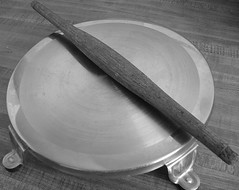
A few years ago, I was at a dinner party in NYC and met a wonderful German couple. It turned out that they were both vegetarians and enthusiastic home-cooks, and over the course of the evening, they asked me many questions about Indian food. One of the things they asked was, "Tell us, do you have the recipe for making the perfect roti"? I replied, "The dough is simply flour and water, with a touch of salt. Then you have to make rotis every day for 10 years, and you will know how to make the perfect roti". I was only half joking. The world's breads only call for the simplest of ingredients- flour, water, a touch of salt, sometimes yeast- but it can take years of practice, practice, practice to get them right.
The perfect roti is a sublime creation. Hot from the griddle, meltingly soft, it is one of life's simple pleasures to tear a piece off the roti, wrap it around a delicious curry and savor the taste of pure whole-wheat goodness. If I have one burning desire as a home cook, it is to learn how to make the perfect roti. The picture above shows the simple tools of roti-making, and I know the Marathi names for these: a small platform for rolling, called polpat (this is usually wooden, but mine is made of metal, and I do love how easy it is to clean), and the rolling pin or latne (called a belan in Hindi).
During all those years in NYC, my tiny kitchen (see the end of this post) made it genuinely difficult to make rotis on a routine basis. But starting with my move to St. Louis (and to a slightly bigger kitchen), I have been making rotis every 3-4 days with dogged determination. I know that, devoid of any inborn roti-rolling talent, my only choice is to persevere. This is what I have learnt so far.
1. Making the dough: Roti dough contains whole-wheat flour (the finely-ground Indian kind, called chapati flour or atta), water and a touch of salt. I use 2 cups of flour for 12 small rotis (perfect for serving 2 piggies or 3 normal people). When I tried adding any quantity of oil into the dough (with the intention of making it softer), I ended up with poor results. So I don't add any oil whatsoever to the dough. The dough is easily kneaded by hand, but I like using my food processor (with the dough blade). If you do use a food processor, please learn from my mistakes: I would place the flour and salt in the bowl, pulse it together, then leave the motor running and dribble in water through the feed tube until the ball of dough came together. This was a mistake. By the time the ball of dough comes together in the food processor, it is too wet! Now, I just dribble in water until the mixture is "pebbly" and forming small clumps of dough. Then, I take the mixture out and knead by hand for 5 minutes without adding any more water. Once a soft, springy ball of dough is ready, set it in a bowl, cover the ball with a damp cheesecloth and then place a cover on the bowl. Let it rest for 30 minutes.
2. Getting ready:

I have two containers dedicated to the roti-making process, as shown above. One contains atta, for sprinkling on the dough and on the surface while rolling it out. The other contains some oil (I use olive oil, you can use any vegetable oil or ghee if you feeling luxurious) to brush on to the finished rotis. I keep these containers handy, then place a griddle on the stove (cast iron is best, but I still don't own one, and make do with a non-stick pan instead).
3. I start by kneading the rested dough again for 2-3 minutes, then divide the dough into 12 little balls. Pat down the dough, score into quarters, then divide each quarter into 3 equal pieces, like so:
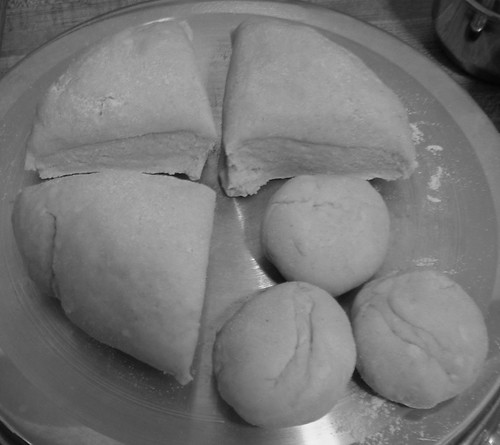
4. Dip each ball into the flour, dust off the excess then use the platform and rolling pin to roll it out evenly into a thin circle. I don't know what to say about this bit, other than, it is taking me some time to master! I then bake the roti on a hot griddle, without adding any oil, until brown spots appear on each side.

Now place the roti directly on the flame for a few seconds on each side. It will puff up (hopefully) and cook to perfection. This can be done either by lighting a second burner (on a low flame) or pulling the pan off for a few seconds at a time and using the flame under the pan. Usually, if I am making rotis alone, I light a second burner. But often, V and I make rotis together...I roll them out, and he roasts them, and in this situation, he can easily pull the pan off and use the same flame for the final puffing of the roti.
5. Finally, once the roti is cooked, I brush on a tiny bit of oil. So the roti only gets a touch of oil at the very end (not in the dough and not while cooking).
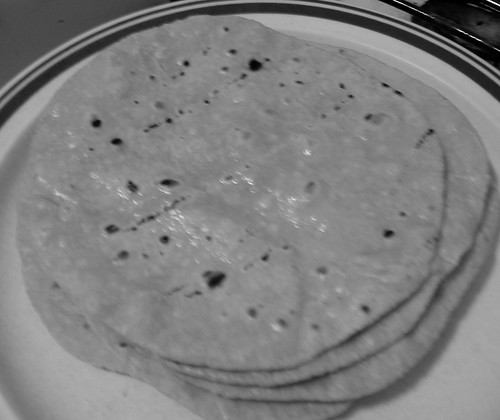
That is my little roti-making story. Right now, my rotis stand at a B minus, they are quite soft and edible when fresh but get hard and chewy in a few hours. Ask me in a few years, and I hope to proudly tell you about my A plus rotis! :) Meanwhile, if anyone has a tried-and-tested tip for improving my roti skills, I will be grateful for your advice.
Coffee of My Khazana of Recipes hosts a fun monthly event called Monthly Blog Patrolling. The premise is that you patrol the blogosphere, make a recipe from another blog and write about it. This month's theme is Let's Roll, where one has to find recipes that involve the use of a rolling pin! This event was just perfect for practicing my rolling skills. Here are my two entries:
When Asha sent in this delicious Carrot Roti as her contribution to the G of Indian Vegetables, I knew I had to make it right away. It is such a great recipe- taking a nutritious and colorful vegetable like the carrot and converting it into a healthy and tasty brunch. The only change I made in the recipe was to omit the oil from the dough.
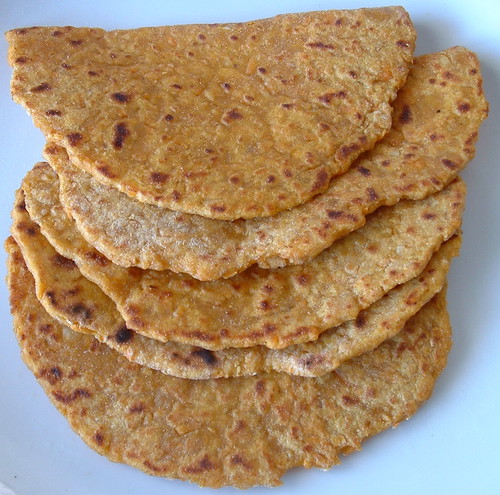
We enjoyed it very much, so thanks, Asha! I know I will be making this roti often.
The second recipe was also a must-try from the moment I saw it on Manasi's blog. She made this delicious Koki, a paratha traditionally made by the Sindhi community of India. I am such a fan of regional recipes, and made it right away. Again, the only change I made was to leave out the oil from the dough. The sesame and grated mango make this paratha completely delicious! I know I will be making this to take along on picnics and trips. Thanks, Manasi!
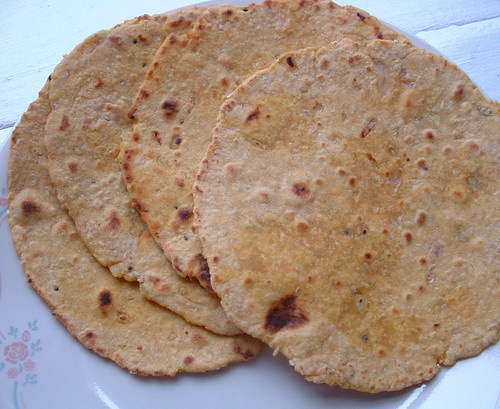
See you in a few!

You are welcome Nupur,glad you enjoyed it!:))Great info for soft cahpatis,thanks.
ReplyDeleteI love your rolling platform there in steel and I have a steel rolling pin I bought in B'lore long time ago.I also recently a non-stick rolling pin at Williams Sonoma and I LOVE it!:))
Lovely post!!!!! What a detailed elaborate info on making roti's!!!!
ReplyDeleteJust a small tip for A plus rotis...... to keep the roti's soft even after a few hours add about 1/2 tsp ghee of oil to the flour while making the dough and then once the dough is made again take half tsp ghee or oil and knead again...... make the dough slightly in advance and cover the vessle with a moist cloth and keep for 1-2 hours..... roti's will remain soft even till next day. :)
Thanks for the lovely entry Nupur!!! Hope you find the tip useful. :)
dear nupur, try this trick for puffing up the phulkas. roast only 1 side lightly and the other till done , then turn it over and put only the half roasted side on flame ........and the roti will blow up automatically. once it is blown its done, no need to put other side on fire. try it out. all the best.luv yoma.
ReplyDeletenice post...I just buy homemade rotis from a gujju female locally since me and my DH need rotis everyday and making them daily is impossible.Btw why the pics in grey? Also the best after years of trying several atta's i think the best one is Natures Valley and 2nd is Sujata. Laxmi aata has maida so the rotis are hard.
ReplyDeleteAsha, a non-stick rolling pin? I would love to give that a shot!
ReplyDeleteCoffee, appreciate the tips very much! I'm going to try that next time, I'll let you know the results :)
Yoma, thanks! Nice to see you back here? Are you back from Chennai?
Supriya, Sorry to say this, but "gujju female" sounds crude. Wouldn't it be nice to call her a "Gujarati lady" instead?
Hi Nupur,
ReplyDeleteHappy Gudi Padwa!Great post about making rotis.Thank you for all the details.I use lukewarm water to knead the dough.I made your gobi paratha over the weekend.It was great.The detailed post was really helpful for making Gobi Paratha.Thank you.Durga
Hi Nupur! ur koki loks gr8!!!and healthier, with less oil!!Gr8 info on making fulkas! I know what u mean by rotis becoming hard after a few hours, u can try adding a few tbsp. of milk when making the dough, coffee's tip is gr8 too. I have a small round grill kinda thingy for making fulkas (which is available in Indian stores)as my stove has coils.Maybe i'll post about it someday...
ReplyDeletenups,
ReplyDeletegotta tell u this, since my folks are from U.P, the chapati or the lack there of my chapati making skills is the one thing thats keeping me single.
Jokes aside, that was mom's threat to me, every year, come summer vacation time. She would try and get me to learn how to make chapatis. Thank god dad enrolled me in some or the other classes and that kept me out of mom's hands.
I havent been able to make the perfect chapatis yet but have noticed that simple flour salt and water combo does not do it for me. If I add tofu, or milk or cheese, the dough turns out soft and the chapatis puff up. Maybe you need to try substituting the water with milk till you are confident of your chapatis. Also , the thinner they are rolled and the more uniform they are in thickness, the better they fluff.
hi Nupur, lovely post! even though you were joking it REALLY takes that many years to master the art of making soft rotis :-(
ReplyDeleteI'll happily call myself a master chef when i master that art, hopefully sooner than later.
BTW wish you a very Happy Gudi Padwa!
cheers!
Hi Nupur - thanks for all the tips on roti-making! Soft and yummy when fresh would work for me - they wouldn't last long enough to test them hours later! I watched a coworker make these long ago and I remember she used something like a tortilla press with a little plastic wrap to keep it from sticking. I've always wanted to try making these, but I don't have a gas stove. I recently came across a tip in a book - you can bend a wire clothes hanger so that it will hold the roti over an electric burner. Haven't tried it yet, but very much want to!
ReplyDeleteInstead of adding water, try adding warm milk or lil warm milk + butter milk or a spoon of yogurt .. that gives you softer rotis.
ReplyDeleteHi Nupur,
ReplyDeleteHappy Gudi Padwa !! Nice post about making rotis .. Even i use Sujata Atta as supriya mentioned above. It is the best whole wheat flour u get in US. And some more tips for keeping rotis soft..
1. Dont let any side of the roti stay on the tava or flame for long, you should keep flipping it faster.
2. I keep the rotis covered immediately after making them in a cloth or the kitchen paper towel, and slightly close the lid of the container. I also keep shuffling the cooked rotis inside the container while i am making the rest.
Regards,
Rashmi.
Unfortunately, I have a electric coil stove and dont have the luxury of placing the rotis directly on a flame:(
ReplyDeleteIn my experience, Warm water is much better than plain cold water and makes my rotis much softer..:)
Few friends even suggested adding Yougurt (2 tsp ) or so, but I havent tried it.
I have been making rotis for three years and have currently regained interest in rolling rotis from scratch:) It gives an innate pleasure that you can roll round rotis which are soft and chewy, isnt it?
Hi Durga...hmm...I always used cold water from the tap. Lukewarm water is a great idea! Thanks for trying the gobi paratha, and I'm so glad it worked out!
ReplyDeleteManasi, I'll definitely try a version with the milk and see how that works...thanks for sharing the tip. Would love to see your post about making rotis on electric stoves...I know that a lot of people would benefit from that info!
bilbo-rani, let me get this straight! You mom, the culinary expert, offered to give you private lessons and you ran off and did something else??!! You could have learnt and taught us all! I hope you will remedy this by learning on your next trip home!! :) :) and ooh, tofu in roti dough. very intriguing, I must try it! Thanks for all the advice, girl.
Hi Richa :) not joking at all, I'm finding out myself that the art of roti-making takes devotion! Happy Gudi Padwa to you too!
Cathy, I have never used one of those tortilla-presses. Call me old-fashioned, but I like the idea of rolling them out the traditional way! You know, I had an electric coil-stove in NYC too, another damper on the roti-making! But other Indian flatbreads like parathas don't involve any direct-heat baking at all. They can be made on a simple griddle.
Sam, thanks! Will try those ideas soon.
Rashmi, I can tell just from your comment that you make rotis with extreme love and care! Thanks for the tips!
Rays of sun, I'm going to try the yogurt addition, lots of people seem to find that it works. It is indeed very rewarding when the rotis turn out well.
Nice post Nupur. I loved the steel rolling pin. Now I too will try to make it softer.
ReplyDeletecheers
sharmi
Such wonderfully detailed instructions. Thanks very much :)
ReplyDeleteNavavarshyachya Hardik Shubheccha!
ReplyDeleteNaveen varsha tula ani V la shukh ani samruddhi cha jaavo hich asha!
Swapna
Thanks so much! I am a terrible roti-maker. I embarked on "roti-boot-cap" last summer to try and improve - and did somewhat, but only somewhat. I'm still not very consistent about it. I'm going to use this article as inspeiration for another try.
ReplyDeleteI have the Indian rolling pin, and love it (use it for all kinds of stuff), but not the little stand. Hmmmmm...may have to track that down.
Wish me luck for Roti Boot Camp 2007!
I just found your blog comparing recipes for Aloo Mutter Gobi. I love your blog and will have to read the whole thing. Your breads look yummy. I will have to try them on the weekend. Yumm-o! Almost dinner time!
ReplyDeleteNice detailed description for roti making technique. Used to eat the phulkas' with fresh honey (literally - there used to be a guy at my mama's place who would climb up the tree with a bidi and then blow on the the bees and thus fresh honey) whenever it rained. Anyways will try out this recepie of yours for sure and try to impress my wife (now rolling it would be another story). Thanks Nupur.
ReplyDeleteSamir
Cottage cheese used to mix dough definetly makes rotis soft. Try it. Good post, thanks.
ReplyDeleteI am so glad to have read this, as I tried making Akki Roti (I have Celiac so I can't eat wheat), inspired by another post of yours. They tasted wonderful, but got a thumbs down in the visual department. I can see now that it will take years of practice to get them right. Do you have any idea where I can purchase Indian equipment (like the tava) here in the US? Indian food is one cuisine that, as a Celiac, very much allows me to accomodate my dietary restrictions. So thanks for your wonderful blog!
ReplyDeleteSharmi, The rolling pin is actually wooden, it is the platform that is made of steel.
ReplyDeleteShripriya, glad you liked it!
Swapna, Happy Gudi padwa to you and your family too! Thank you so much for the sweet wishes :)
Diane, I desperately need roti boot-camp too! The little platform should be available in Indian stores. Or if you have a friend who is going to India, you could ask them to bring one back for you. Good luck with roti-making this year!
Veg-a-nut, Glad you found my blog! Do visit often :)
Samir, what a story! Fresh phulkas are something else. I;m sure your wife will be impressed with any efforts you make towards fresh hot rotis!
Poornima, thanks for the tip!
Oh..I forgot to add..the dough can be 'fridged' & used for upto (gulp!)a wk (I don't really do this that often, I swear!). Just leave it out for ~30min before you start rolling & it's good to go.
ReplyDeleteCheers!
Such a great post! I can eat my weight in rotis! I wish you lots of luck in your goal to the perfect roti...Gosh, if I made these at home they would soon have to winch me out the door!
ReplyDeleteI make rotis (more specifically phulkas) daily. And, after coming to US, the only tip I have is use really good flour - some from here have additives. I prefer to use Shakti Bhog Atta whenever I can lay my hands on it or else I buy the Sujatha brand flour.
ReplyDeleteAnd, the only other thing is that the dough needs to be kneaded really well - but your processor does it for you , so :)
Hi Nupur.
ReplyDeleteI al always striving to make the perfect roti. I don't have tips, but I can tell you, it is really way harder to do phulkas if you have the smooth-top range ( the one where the coil is under). My MIL optimized conditions and now I can makie fairly decent chappatis. The one tip that really seems to make a difference is
buy flour that is "Made in India". I really do see a difference. Sujatha flour is good. I used to buy stuff labeled Atta but made in Canada etc..., but this really makes a difference.
It is possible that rotis are getting hard because the griddle is getting too hot ( this is a tricky issue, if griddle not hot, again problems arise).
Adding oil or no oil to dough does not make much difference to mine.
Make sure you don't roll the roti too thin, that definitely makes it hard and crisp.. at least that is my problem. I have a tendency to keep stretching.
But like you, I am always in search for the tip that will turn my roti into a master piece.
If my rotis get hard when it is cold, I have lately been breaking it into pieces and soaking it in hot milk with sugar and eating it for breakfast like cereal.. I used to love this as a child. My children won't eat it though.
hi Nupur,
ReplyDeleteI totally agree with you....roti making is an art in itself!! Sometimes i get great results, but cant say so consistently. Maybe more practice is needed.....i cant seem to get a perfect round one anyways!! great post this one.
Several days late, and a euro short.... try the pasta roller for rolling out if rolling out is an issue.
ReplyDeleteNupur all of them look great. I agree with you on roti. I think I am hobering between B- and C. Mostly in the shape department!
ReplyDeletehey nupur , great post , attention to detail is impressive ,I just started blogging and came across ur blog , A - Z is a very interesting idea .....love it !
ReplyDeleteHi Nupur, I *love* the black and white-ish photos at the beginning of this post! Love the utensils and the bread in that tone. Really lovely writeup as well -- makes me want to beg borrow or steal a nice hot fresh roti right now! :)
ReplyDeleteEllen, you must have read about the akki roti on another blog, I have never tried making it myself :) About purchasing a tava, try using a cast iron pan. Indian equipment is quite easy to find online, or in Indian stores. Most large cities in the US do have one or more Indian stores. I's so glad you are enjoying Indian cuisine!!
ReplyDeleteShvetha, very useful tip, thanks!! There are times when I would love to make the dough ahead of time.
Joey, me too :) That's why I make 'em every few days ;)
Sana, thanks for the useful tips! You make phulkas daily...that is the sort of thing that really makes one an expert!
Thodarumm, thanks so much for the detailed advice! I must remember the breakfast tip for eating leftover rotis :)
Suma, thanks! One day we will all be experts :)
Judith, glad the commenting tip worked!
Mandira, the shape department is the most demanding one, alas :)
Rahin, thanks! Glad you like it :) Do participate in the A-Z if you feel like it...we are on the letter I (i) right now.
Linda, the B-W photos were a little experiment. I took the photos at night, in the ugly yellow light of my kitchen, and wanted to find some way of making them more presentable, for whatever that is worth :)
Hi Nupur..realized my first comment didn't go online..probby coz it was too long! Anyway to sum it up, I use just water (no oil/milk) to knead a dough that's quite wet. When you roll out the rotis from this dough they are soft enuf to not need the oil/ghee touch-up at the end.
ReplyDeleteAnd this is where I *forgot* & folld with the other comment
:-)
I adore roti but have never had the courage to attempt it. In Boston there is a lovely family from Trinidad who make roti, filled with wonderful spicy veggies or shrimp or meat or goat, every Saturday. I have watched and watched as they roll out up to 500 roti every Saturday morning! During the week, everyone in the family works elsewhere -- doctors, accountants, etc. -- but on Saturdays they make roti. Thank you for the wonderful photos and description of your process.
ReplyDeleteI adore rotis. When I lived in Grenada a Trinidadian friend taught me how to make one version. She gave me a griddle called a tawa and showed me how to pull the tawa over on the stovetop so you could get the roti directly over the flame and make it puff up. I must try making these again. We didn't use whole wheat at that time; that would make them extra good. Thanks for all the details and tips.
ReplyDeleteWonderful writeup Nupur and definitely the rotis looks so good...
ReplyDeleteHi Nupur,
ReplyDeleteOf late, having moved apts from the 'coil stove' to the 'flame-stove', I am now a regular roti-maker, at least say 4 times a week...Fortunately, the phulkas fluff up in say, 95% of the cases! Yoma's comment above is my secret too, you HAVE to only half-cook one side of the roti, then cook the other side completely, then put the half cooked side onto the flame..
Also, a little bit of oil and NO salt is how I make my dough.. Works great for me.. Besides, I have noticed that if you have a thinner rolling pin, the rotis are that much better..
Temperature control during the whole process is v imp too. If the tava gets overheated, I simply 'sim' the flame for say a minute or two. However, WHILE making rotis if the flame is low, rotis would turn out harder. The flame has to be on high while the roti is on the pan/flame.
In your last step, you have added oil. Try replacing it with ghee instead for tastier, softer phulka rotis.. Hope you find these tips useful!
hey...
ReplyDeletejus one question....the other day i made rotis ,brushed with litte ghee n stored in a cloth coz my hubby comes little late....but they became hard...gosh pls help...!
Hi Nupur,
ReplyDeleteWhich food processor do you use? The next thing to buy on my shopping list is a food processor and I can't make up my mind on which one to buy.
Thanx!
Shubha
hi, I make roti with 4 cups white cake flour, 4 tablespoon milk powder, 1/2 cup oil, 1 tablespoon butter, 1 & 1/4 teaspoon salt & 2 cup boiling hot water from the kettle. mix flour & milk powder & salt. add butter & 3/4 of oil & stir in boiling hot water. wait for mixture to cool and knead till dough ball forms. add rest of oil and knead for 5-7 minutes till very soft. make balls & cover & allow dough to rest for 15-30minutes and then roll out & fry. roti stays super soft.
ReplyDelete